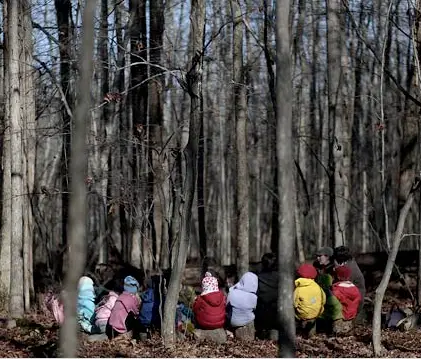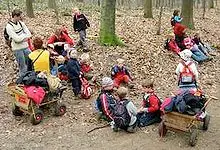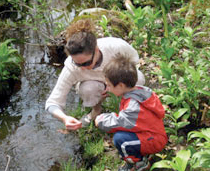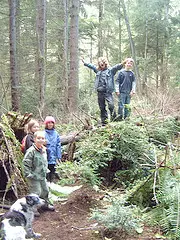The numbers are small so far in the U.S., but the idea is well established in Europe, with schools in Scotland, England, and Switzerland. By far the most such schools are in Germany, which has more than 400 Waldkindergartens.
 Some schools feature several hours of outdoor schooling. This is certainly the case with the Waldorf School of Saratoga Springs. Children attending that particular school enjoy a good amount of outdoor education each day, rain or shine. They know to come with layers of clothing because they know that they will be venturing out on the nearby Hemlock Trail to learn more about the natural world around them. Some lessons are focused on nature; others are academic topics delivered in a natural setting. In all cases, students are active — not sitting at desks or on mats on the floor but walking, running, jumping, solving problems like how to get the mud off the bottoms of their shoes before their parents find out.
Some schools feature several hours of outdoor schooling. This is certainly the case with the Waldorf School of Saratoga Springs. Children attending that particular school enjoy a good amount of outdoor education each day, rain or shine. They know to come with layers of clothing because they know that they will be venturing out on the nearby Hemlock Trail to learn more about the natural world around them. Some lessons are focused on nature; others are academic topics delivered in a natural setting. In all cases, students are active — not sitting at desks or on mats on the floor but walking, running, jumping, solving problems like how to get the mud off the bottoms of their shoes before their parents find out. Seriously, the focus is on activity at these schools. Even lessons on words and numbers involve the children's being active because the teacher leads the class to an outdoor "classroom." All of this activity just has to be good for the children's physical systems as well, and studies have supported just that conclusion over the years (including the fact that children's immune systems actually get stronger after all of the outdoor activity). Other studies have shown that graduates of Waldkindergartens show a higher ability to learn when they progress through their academic careers.
Seriously, the focus is on activity at these schools. Even lessons on words and numbers involve the children's being active because the teacher leads the class to an outdoor "classroom." All of this activity just has to be good for the children's physical systems as well, and studies have supported just that conclusion over the years (including the fact that children's immune systems actually get stronger after all of the outdoor activity). Other studies have shown that graduates of Waldkindergartens show a higher ability to learn when they progress through their academic careers.Other schools are all outdoors, al the time. This is the case with the Cedar Song Nature School, on Vashon Island, Wash. Students at this school come dressed for the weather, all right, but they spend their whole three-hour day outdoors, in a private five-acre forest, doing all manner of physical activities but also learning much more than "just what nature has to offer."
 The school, begun in 2008, runs four days a week. Organizers, one of whom traded in her law practice to help start the school, hope to expand the schoolweek to five days soon.
The school, begun in 2008, runs four days a week. Organizers, one of whom traded in her law practice to help start the school, hope to expand the schoolweek to five days soon.At these forest kindergartens, students learn science by observing and doing it, learn math by applying it to the natural world around them, learn letters and words by putting them together using sights and sounds. The children learn to make comparisons using mundane things like pine cones and rocks. (Which pine cone is the largest? Which rock is the shiniest?) They develop an appreciation for animals and plants in their natural environment — not just by looking at pictures in a book or on a computer screen.
 Some of the science activities involve teamwork (like demonstrating the best way to move a heavy object (showing how a lever works, anyone?). In other sessions, teachers encourage students to develop their motor skills by building wooden tools such as hammers and cutlery.
Some of the science activities involve teamwork (like demonstrating the best way to move a heavy object (showing how a lever works, anyone?). In other sessions, teachers encourage students to develop their motor skills by building wooden tools such as hammers and cutlery.These students also learn how to get along with one another, individually and in a group. They also develop healthy levels of self-confidence, just from being able to do the everyday activities that the school offers.
In a time when so many children are being classified as obese because of their obsession with sedentary activities like watching television and playing videogames, these outdoor schools serve as a reminder that before the advent of the "screen mentality," children learned just as much, if not more, from opening their eyes to the (nonvirtual) world around them. By: socialstudiesforkids.com

Comments (0)
Post a Comment